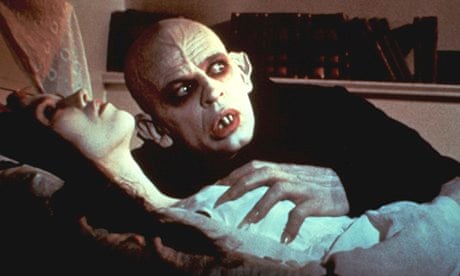Werner Herzog's 1979 film Nosferatu the Vampyre, starring Klaus Kinski as the emulsion-faced undead parasite, is now re-released nationally as part of the BFI Southbank Gothic season. It is his homage to the 1922 FW Murnau movie, conceived and executed with passionate connoisseurship; Herzog develops the first film, making the final sexualised sacrifice more explicit, keeping some original locations and images, and approximating the operatic visual language of Murnau with a new kind of primitivism: strange tableaux, eerie wordless scenes, and juxtaposed, grainy images of bats that directly reference silent moviemaking. Kinski is every bit as bizarre in the leading role; the Count's glittering amour-propre and menace may have a little bit of Mel Brooks about them, but Kinski carries it all off with glassy-eyed fervour and fathomless agony, as the Count prepares to carry his anti-enlightenment into the heart of 19th-century Germany. Kinski really is scary. What can it have been like for Bruno Ganz to play opposite him, as Harker, the luckless visitor to his sinister castle who, by accidentally cutting himself with a bread knife over dinner, gets the thirsty Count's rapt and undivided attention? This is Herzog's journey to the heart of darkness, a film that specifically echoes his earlier offerings The Enigma of Kaspar Hauser and his South American odyssey Aguirre, Wrath of God.

Klaus Kinski is genuinely scary as the bloodthirsty Count in Werner Herzog's homage to the 1922 FW Murnau movie
Explore more on these topics
Comments (…)
Sign in or create your Guardian account to join the discussion